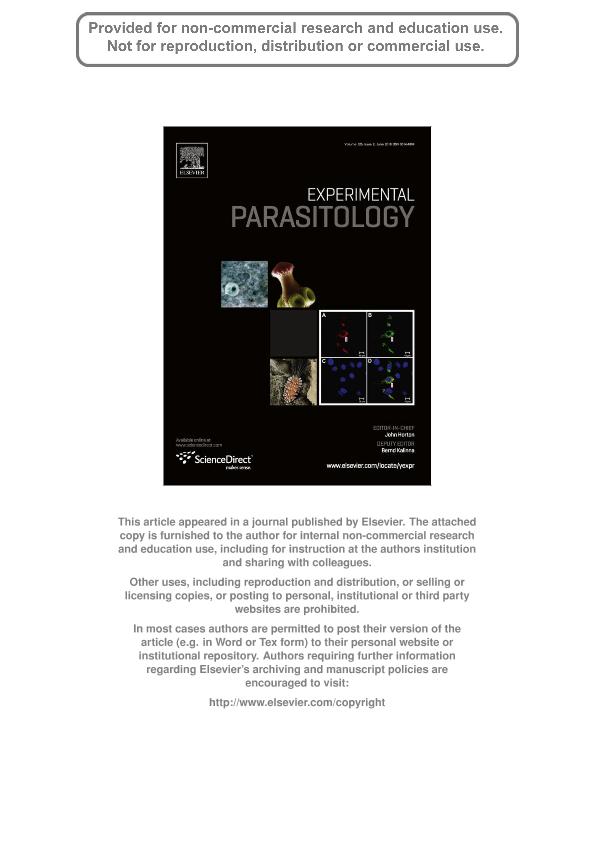Artículo
Cattle nematodes resistant to macrocyclic lactones: Comparative effects of P-glycoprotein modulation on the efficacy and disposition kinetics of ivermectin and moxidectin
Lifschitz, Adrian Luis ; Suarez, Víctor Humberto; Sallovitz, Juan Manuel; Cristel, S. L.; Imperiale, Fernanda Andrea
; Suarez, Víctor Humberto; Sallovitz, Juan Manuel; Cristel, S. L.; Imperiale, Fernanda Andrea ; Ahoussou, S.; Schiavi, C.; Lanusse, Carlos Edmundo
; Ahoussou, S.; Schiavi, C.; Lanusse, Carlos Edmundo
 ; Suarez, Víctor Humberto; Sallovitz, Juan Manuel; Cristel, S. L.; Imperiale, Fernanda Andrea
; Suarez, Víctor Humberto; Sallovitz, Juan Manuel; Cristel, S. L.; Imperiale, Fernanda Andrea ; Ahoussou, S.; Schiavi, C.; Lanusse, Carlos Edmundo
; Ahoussou, S.; Schiavi, C.; Lanusse, Carlos Edmundo
Fecha de publicación:
06/2010
Editorial:
Academic Press Inc Elsevier Science
Revista:
Experimental Parasitology
ISSN:
0014-4894
Idioma:
Inglés
Tipo de recurso:
Artículo publicado
Clasificación temática:
Resumen
The role of the drug efflux pump, known as P-glycoprotein, in the pharmacokinetic disposition (host) and resistance mechanisms (target parasites) of the macrocyclic lactone (ML) antiparasitic compounds has been demonstrated. To achieve a deeper comprehension on the relationship between their pharmacokinetic and pharmacodynamic behaviors, the aim of the current work was to assess the comparative effect of loperamide, a well-established P-glycoprotein modulator, on the ivermectin and moxidectin disposition kinetics and efficacy against resistant nematodes in cattle. Fifty (50) Aberdeen Angus male calves were divided into five (5) experimental groups. Group A remained as an untreated control. Animals in the other experimental Groups received ivermectin (Group B) and moxidectin (Group C) (200. μg/kg, subcutaneuosly) given alone or co-administered with loperamide (0.4. mg/kg, three times every 24. h) (Groups D and E). Blood samples were collected over 30. days post-treatment and drug plasma concentrations were measured by HPLC with fluorescence detection. Estimation of the anthelmintic efficacy for the different drug treatments was performed by the faecal egg count reduction test (FECRT). Nematode larvae were identified by pooled faecal cultures for each experimental group. Cooperia spp. and Ostertagia spp. were the largely predominant nematode larvae in pre-treatment cultures. A low nematodicidal efficacy (measured by the FECRT) was observed for both ivermectin (23%) and moxidectin (69%) in cattle, which agrees with a high degree of resistance to both molecules. Cooperia spp. was the most abundant nematode species recovered after the different drug treatments. The egg output reduction values increased from 23% to 50% (ivermectin) and from 69% to 87% (moxidectin) following their co-administration with loperamide. Enhanced systemic concentrations and an altered disposition of both ML in cattle, which correlates with a tendency to increased anthelmintic efficacy, were observed in the presence of loperamide. Overall, the in vivo modulation of P-glycoprotein activity modified the kinetic behavior and improved the efficacy of the ML against resistant nematodes in cattle. The work provides further evidence on the high degree of resistance to ML in cattle nematodes and, shows for the first time under field conditions, that modulation of P-glycoprotein may be a valid pharmacological approach to improve the activity and extend the lifespan of these antiparasitic molecules.
Palabras clave:
IVERMECTIN
,
MOXIDECTIN
,
P-GLYCOPROTEIN
,
RESISTANT NEMATODES IN CATTLE
Archivos asociados
Licencia
Identificadores
Colecciones
Articulos(CIVETAN)
Articulos de CENTRO DE INVESTIGACION VETERINARIA DE TANDIL
Articulos de CENTRO DE INVESTIGACION VETERINARIA DE TANDIL
Citación
Lifschitz, Adrian Luis; Suarez, Víctor Humberto; Sallovitz, Juan Manuel; Cristel, S. L.; Imperiale, Fernanda Andrea; et al.; Cattle nematodes resistant to macrocyclic lactones: Comparative effects of P-glycoprotein modulation on the efficacy and disposition kinetics of ivermectin and moxidectin; Academic Press Inc Elsevier Science; Experimental Parasitology; 125; 2; 6-2010; 172-178
Compartir
Altmétricas



